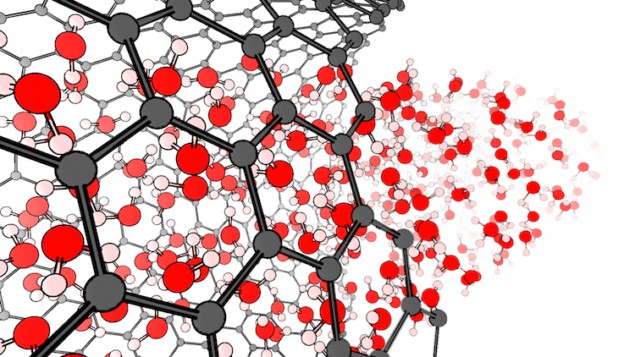‘Quantum brakes’ slow water flow through carbon nanotubes
23 Mar 2022 Isabelle Dumé

When water moves through nano-sized channels made of carbon, its flow rate is much higher than current theories of fluid dynamics predict. New work by researchers at the École Normale Supérieure (ENS) in Paris, France and the Flatiron Institute in New York, US suggests that a quantum version of friction plays a crucial role in resolving this conundrum. The team’s findings could have important implications for applications such as filtering salt from seawater or generating energy.
Experimentalists have known for more than a decade that, paradoxically, fluids such as water pass more easily through narrower carbon nanotubes – rolled-up sheets of carbon as little as one atom thick – than through wider ones. The effect is strongest for nanotubes constructed from more than one layer of carbon sheets. A further puzzle is that while fluids flow with hardly any friction through all sizes of channel thanks to the extreme smoothness of the nanotube walls, the friction that is present is hard to explain.
In 2016, Lydéric Bocquet and colleagues at the ENS revealed that the amount of friction increases for larger-diameter nanotubes. In principle, this could explain why water flows more easily through narrower tubes. However, the result was confusing because the walls of larger tubes are just as smooth as smaller ones.
A wall isn’t just a wall
In the latest work, Lydéric and Marie-Laure Bocquet of the ENS, together with Nikita Kavokine at the Flatiron Institute’s Center for Computational Quantum Physics, studied carbon nanotubes with diameters ranging from 20 to 100 nanometres. The researchers took a new approach, unusual in the field of fluid dynamics, by focusing on the nanotube walls. “In hydrodynamics, the wall is just a wall, and you don’t care what the wall is made of,” Kavokine explains. “We realized that at the nanoscale, it actually becomes very important.”
The researchers found that quantum effects at the wall’s carbon-water interface produce friction by allowing the flowing liquid to dissipate energy by scattering electrons in the carbon. These electrons interact with the water molecules electromagnetically because the latter are polar, with one end of the molecules being slightly positively charged and the other slightly negatively charged.
Kavokine and colleagues say that while the electrons in the carbon move along with the flowing water molecules, they tend to slightly lag behind. This effect, known as electronic or quantum friction, had only been considered in interactions between two solids or a single particle and a solid until now.
Increasing the quantum friction force
Kavokine goes on to explain that the electrons tend to vibrate collectively at a particular frequency. This behaviour is called a plasmon mode, and if water molecules can vibrate at the same frequency, they do so in unison with the electrons, increasing the quantum friction force. This finding explains why frictional effects are strongest for nanotubes with multiple well-aligned layers, since the interlayer motion of the electrons is synchronized with that of the water molecules.READ MORE

Asked why this effect hadn’t been seen before, Kavokine notes that it is very slight even in carbon nanotubes and would be negligible for materials with rougher surfaces. He adds that the effect is also hard to mimic using molecular dynamics simulations, which fail to capture this type of friction because they rely on the so-called Born-Oppenheimer approximation. This approximation assumes that electrons adapt instantly to the motion of nearby atoms, which isn’t the case. “I think this work opens the door to many new quantum interfacial phenomena that we are only beginning to understand,” Kavokine concludes.
Reporting their work in Nature, the researchers now plan to return to their experiments and explore the practical consequences of their quantum friction theory. “We would like to systematically investigate the effect of electronic properties on friction,” Bocquet tells Physics World. “Our investigations will also continue on the theoretical side.”

Isabelle Dumé is a contributing editor to Physics World
from physicsworld.com 7/4/2022
Δεν υπάρχουν σχόλια:
Δημοσίευση σχολίου